Apprenticeships: Eight things you need to know
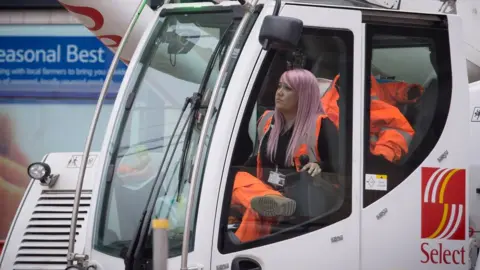 Getty Images
Getty ImagesDespite government plans to create three million apprenticeships by 2020, the number of apprentices starting new programmes in England has dropped.
Apprentices combine on-the-job training with their studies. Most are under the age of 25, and work in the service industries in England.
But radical changes to the way apprenticeships in the UK work were introduced in April 2017.
The apprenticeship levy scheme was introduced - a tax on large employers to help fund people training at work.
The government estimates the levy will raise £2.8b in 2018.
But some critics say it might discourage employers from taking on apprentices.
So what's going on?
1. Apprenticeship numbers are down

There were 114,400 apprenticeship starts in England in the three months from August to October 2017, which was 49,800 fewer than a year earlier - a drop of 30%.
The Department for Education said the changes to how apprenticeships were funded were "likely to have impacted on starts" but the levy-payers it had spoken to were planning to increase the number of apprentices they employed in the future.
The new levy applies to all UK employers with a wage bill over £3m - but Scotland, Wales and Northern Ireland manage their own apprenticeship schemes and how they are funded.

How does the apprenticeship levy work?
- UK employers with wage bills of over £3m pay 0.5% of their payroll into a central apprenticeships fund
- Levy payments are translated into vouchers that larger public and private sector companies can use to fund apprenticeships
- Companies with a wage bill of less than £3m pay 10% of training costs directly to the provider, with the government paying the remaining 90%, up to a funding band maximum
- The government provides all of the funding for training 16- to 18-year-old apprentices if a company has fewer than 50 employees

2. Employers 'don't understand the new levy'
The government estimated the new levy would affect only about 2% of employers in the UK. But a survey of more than 1,000 UK employers released by the HR industry body the Chartered Institute for Personnel and Development (CIPD) suggested about a third currently pay it.
According to the CIPD survey, 22% of employers don't know whether they have to pay the levy or not.
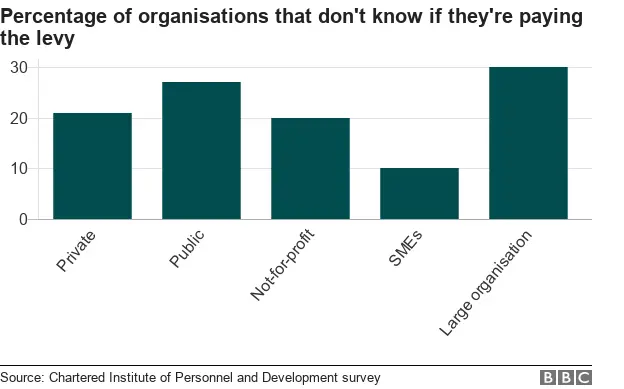
Nearly half of employers surveyed (46%) thought they would be encouraged to "re-badge" existing training schemes as apprenticeships, in order to claim the money back.
The new levy has drawn criticism from the likes of the Institute of Directors, who said many businesses did not understand how the new system worked and that one in 10 of their members wrote the levy off as a tax.
But Anne Milton, Apprenticeships and Skills Minister, said: "There have been significant changes for employers and training providers since April 2017, and it's right that they take the time to plan ahead to make sure they get the skilled workforce they need."
The government introduced other apprenticeship changes in 2017, including a 12-month minimum duration for all apprenticeships and a quota of 20% off-the-job training.
3. The health sector is the most popular among apprentices
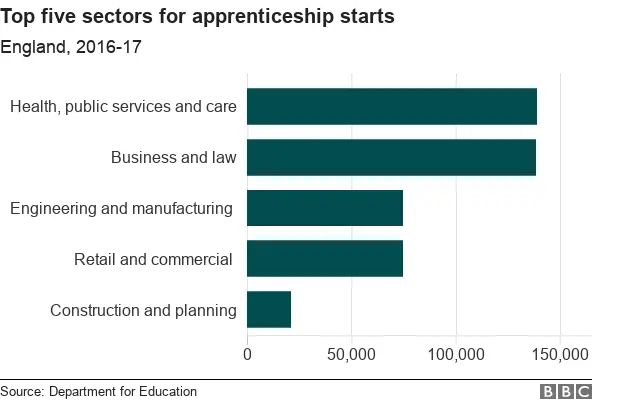
Health, business, engineering, retail and construction were the most popular sectors for new apprentices in England last year.
Most starts were in two of those sectors, which accounted for 277,330 between them:
- health, public services and care
- business, administration and law
Intermediate, the first level of apprenticeship, roles might include an IT coordinator, a mental health support worker or a bricklaying apprentice.
4. More women start apprenticeships than men
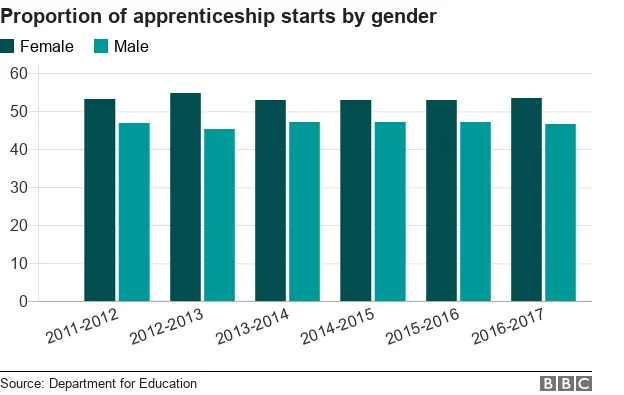
In 2016-17, 54% of apprenticeship starts in England were by women (262,820), compared with 46% by men (228,520).
The number of women starting apprenticeships in England has been higher than men every year since 2010-11.
5. But male apprentices are earning more
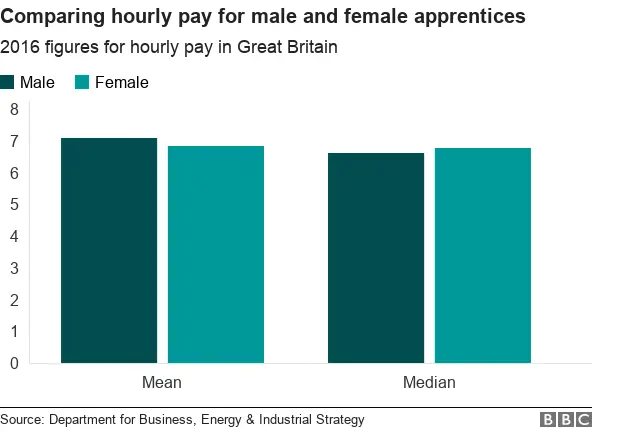
In 2016, male apprentices surveyed by the Department for Business earned on average £7.10 per hour, while women received just £6.85.
But taking the median hourly pay (the middle value when everyone's wages are arranged from highest to lowest) into account, female apprentices earned 17p per hour more.
According to the Young Women's Trust, a charity that campaigns for disadvantaged young women, female apprentices are under-represented in Stem (science, technology, engineering and mathematics) sectors. Male apprentices are concentrated in IT, construction and engineering - sectors that tend to be better paid.
In 2015-16, more than 72,000 male apprentices started programmes in engineering in England, compared with 6,260 women, according to the DfE. By contrast, more than 100,000, or 40% of all female apprentices, started programmes in the health and social care sector.
The Young Women's Trust says action must be taken to improve access for women in Stem sectors, such as introducing mentoring schemes or women-only work experience placements.
6. Apprenticeship achievements are up
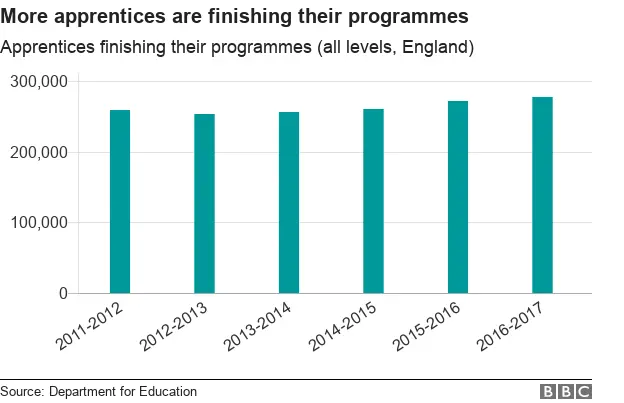
In 2016-17, 277,800 people completed an apprenticeship in England - the highest number since comparable records began in 2002.
Apprentices might not complete their programmes for several reasons:
- leaving one job for another
- returning to school, college or university
- dropping out of the education and training system altogether
7. More apprentices are starting advanced programmes
Although the overall number of apprentices starting new programmes has seen a drop, more apprentices are starting advanced or higher level programmes in England.
Completing an advanced apprenticeship is equivalent to two A-level passes.
Higher apprentices can work towards qualifications such as a foundation degree or the equivalent of a bachelor's degree - without paying tuition fees.
In 2016-17, 53% of apprenticeship starts were at intermediate level, 40% at advanced level and the remaining 7% at higher level.
The proportion of higher and advanced level apprenticeships has climbed steadily from 37% in 2011-12 to 47% in the last academic year.
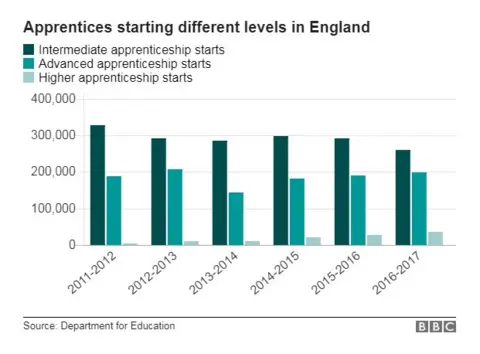
8. How do apprenticeships work across the rest of the UK?
Skills Development Scotland (SDS) recently announced more than 3,500 new-style apprenticeship places for 2018.
Foundation apprentices work towards their qualifications and gain work experience while studying for their National 5s or Highers.
Graduate apprentices can study to master's level, splitting their time between college, university or their employers.
There were also 26,262 modern apprenticeship starts in 2016-17, up 444 from the previous year.
There are three levels of apprenticeships on offer in Wales:
- foundation apprenticeships
- apprenticeships
- higher apprenticeships
More than 24,000 apprenticeship programmes were started in the 2016-17 academic year in Wales.
In the academic year to April 2017, 6,381 apprentices started Level 2 and Level 3 programmes in Northern Ireland, equivalent to five GCSEs at A*-C, or two A-levels.
In Northern Ireland, anyone who has completed their A-levels or equivalent can work towards a higher level apprenticeship, which helps those in work gain qualifications equivalent to a foundation or bachelor's degree or a post-graduate qualification.
